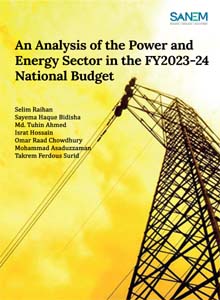An Analysis of the Power and Energy Sector in the FY2023-24 National Budget
 Citation: Raihan, S., Bidisha, S. H., Ahmed, M. T., Hossain, I., Chowdhury, O. R., Asaduzzaman, M., & Surid, T. F. (2024). An Analysis of the Power and Energy Sector in the FY2023-24 National Budget. SANEM Publications, Dhaka, Bangladesh.
Citation: Raihan, S., Bidisha, S. H., Ahmed, M. T., Hossain, I., Chowdhury, O. R., Asaduzzaman, M., & Surid, T. F. (2024). An Analysis of the Power and Energy Sector in the FY2023-24 National Budget. SANEM Publications, Dhaka, Bangladesh.
There is no denying that, to sustain Bangladesh’s growth momentum and address its development challenges, a continuous and uninterrupted energy supply is a prerequisite. Currently, the energy landscape of Bangladesh is primarily characterized by natural gas, with over half of the electricity being generated from domestic natural gas and imported Liquefied Natural Gas (LNG). The remaining power generation comes from sources such as coal, diesel, furnace oil, hydro, and solar (BPDB, 2022). However, the increasing reliance on LNG, especially considering its volatile and expensive nature as an imported energy source, has put significant pressure on the national budget.
In this context, recent disruptions in the global energy supply chain resulting from the Russia-Ukraine war and the ongoing COVID-19 pandemic have further escalated the costs associated with imported energy. Additionally, growing environmental concerns about the adverse effects of heightened fossil fuel consumption, combined with the target of achieving 30% renewable energy (RE) in the country’s total energy mix by 2030, demand a comprehensive assessment and immediate focus on budget allocation and policy planning.
During the fiscal year 2021-22, Bangladesh achieved the significant milestone of providing electricity access to its entire population. Moreover, the country has set ambitious goals for electricity generation, aiming to produce 40,000 megawatts by 2030 and 60,000 megawatts by 2041. However, challenges persist in this context, which include frequent disruptions in electricity generation and the high costs associated with various energy sources. These issues not only have negative consequences on the production processes but also place a burden on daily activities and household expenses.
When it comes to clean energy, the Government of Bangladesh (GoB) has outlined clear targets. By 2041, the aim is to generate 40% of the nation’s electricity from clean sources. In pursuit of this transformation towards clean and renewable energy, the government recently introduced the “Mujib Climate Prosperity Plan” in November 2022. This plan sets even more ambitious RE targets, with the objective of achieving 30% RE by 2030 and 40% by 2041. In this connection, there is also no denying that achieving the goals outlined in the national plans requires comprehensive and long-term financial planning. To successfully meet the targets set forth in policy documents, it is imperative to reconsider and revamp the national budget for the MoPEMR in terms of both expenditure and financing.
In the context of the FY2023-24 budget, it is worth noting that the allocation for the Ministry of Power, Energy, and Mineral Resources (MoPEMR) amounted to BDT 34,819 crore, which represented 4.6% of the national budget and 0.70% of the country’s GDP (MoF, 2023). However, within this allocation, there was a notable disparity between the Power Division (PD) and the Energy and Mineral Resources Division (EMRD).
The Power Division (PD) received an allocation of BDT 33,825 crore, marking a substantial 33.8% increase compared to the previous fiscal year. In contrast, the Energy and Mineral Resources Division (EMRD) was allocated only BDT 994 crore, indicating a significant decrease of 47.7% when compared to the previous year. This allocation trend raises concerns about the prioritization of power generation over energy resource exploration and domestic energy capacity.
When analyzed over the past years, the budgetary allocation for both the PD and MoPEMR has shown a decreasing trend as a percentage of the total budget, with a slight increase observed in FY2023-24, reaching 4.4% and 4.6% respectively. In absolute terms, the budget for EMRD has consistently declined since FY2018-19, dwindling to a mere 0.1% of the total budget. In contrast, the budget for the Power Division has witnessed positive growth. This budgetary discrepancy reflects a potential focus on short-term gains in power generation, often reliant on fuel imports, at the expense of domestic energy capacity and security. This approach risks missing opportunities for significant exploration efforts and substantial growth in renewable energy (RE).
Recognizing the urgency of aligning budgetary priorities with the ambitious targets set in various policy documents for different energy sources, it is crucial to conduct a comprehensive review and redesign the national budget of the Ministry of Power, Energy, and Mineral Resources (MoPEMR). Such a reevaluation should consider both spending and financing aspects, with a focus on achieving long-term energy sustainability, resource exploration, and security, as outlined in the policy objectives.
In the proposed FY2023-24 budget, there also seems to be a notable absence of a concrete action plan for renewable energy (RE) beyond the reaffirmation of targets. While the budget document restates the objectives of achieving 40% from clean energy by 2041, there is a lack of detailed initiatives or strategies to make these targets a reality.
A closer look at the projects listed in the Annual Development Program (ADP) under the power and energy sector reveals that only a handful of them are focused on renewable energy. Furthermore, it’s noteworthy that most of these RE projects appear to be continuations of initiatives from previous years. Additionally, three out of the six renewable energy projects have been allocated lower funding in this fiscal year. As a whole, the total ADP allocation for the power and energy sector has declined by 2.5%. In terms of fiscal incentives for clean energy, apart from the exemption of advance import tax on solar desalination plants to produce fresh water, there were no specific fiscal incentives, instead, there were steps towards encouraging the use of fossil fuel (e.g., removing 15% VAT and 5% advance tax on the import of petroleum goods and furnace oil).
